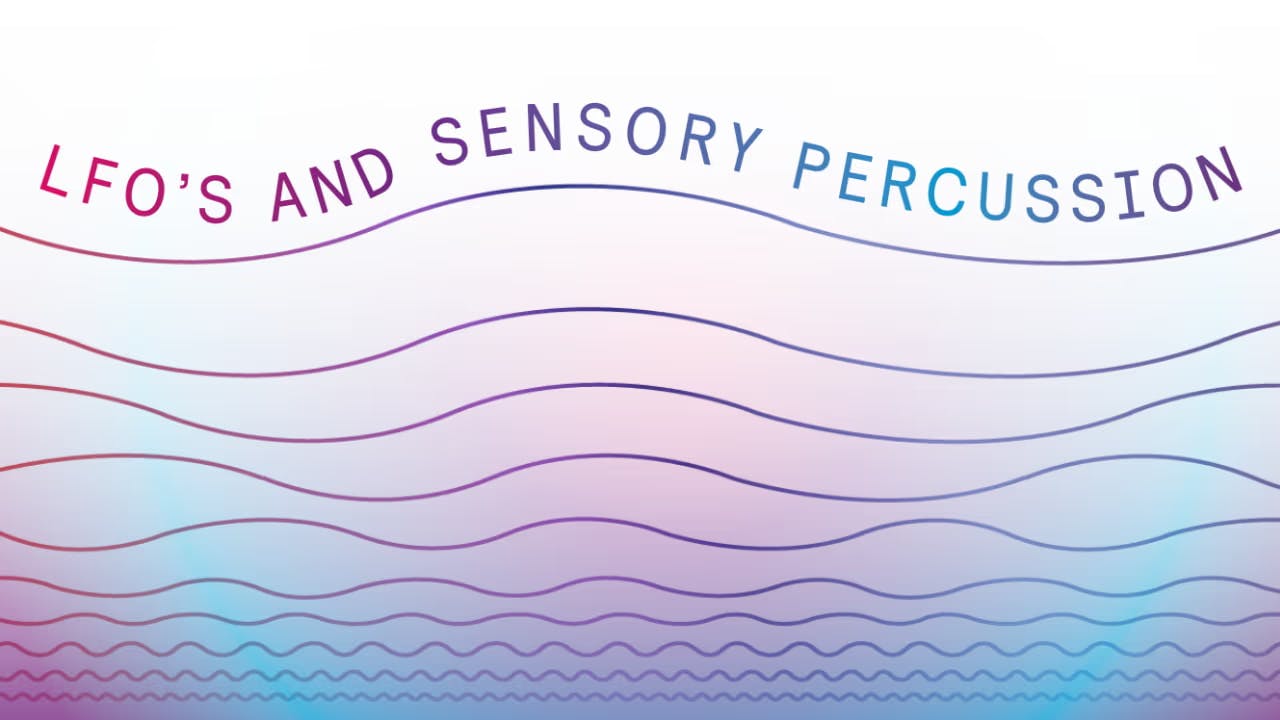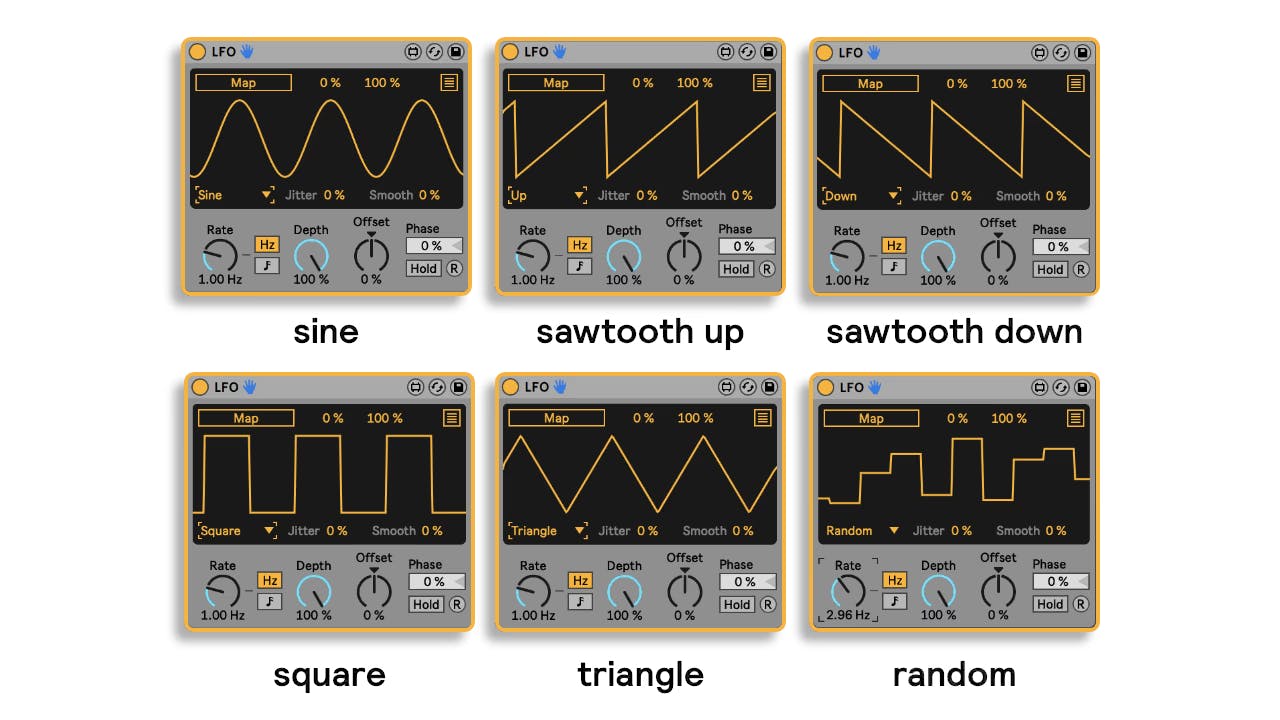
Low frequency oscillators (aka "LFO's") are important tools in the modulation of sonic parameters, which is part of makes synthesizers so much fun. Though the concept comes from old-school hardware synths, LFO's are also used in lots of music production software like Ableton, software synths like Serum, and––most importantly––Sensory Percussion. In this post, we'll go over the basics of LFO's in the abstract and then dive into some Sensory Percussion-specific ways to really spice up your sounds with this powerful tool!
LFO Basics
So what exactly is an LFO, or low frequency oscillator? In general terms, it's an electronic signal that follows a repeated waveform, creating a rhythm through this repetition. The "frequency" part of a low frequency oscillation refers to the time between each repetition of this signal. But don't get confused; LFO's on their own do not produce any sound (low frequency ≠ low pitch). Instead, much like an envelope, an LFO can be assigned to a parameter of an existing sound (volume, filter cutoff, pitch, etc.) to modulate it according to the shape/frequency of its wave. While an envelope has a defined start and end (attack, decay, sustain, release), LFO's are constantly repeating, or oscillating.
In Sensory Percussion terms, LFO's work a lot like any other type of controller: you can find them in the "Controllers" panel and then drag/drop them onto the parameter you want to control. What makes LFO's different from other controller types is that they don't require you to hit the drum at all; they're constantly moving on their own, so they're great for adding some variation to your samples and effects.
Oscillator Shapes

Here, you can see some visualizations of the six main LFO shapes: sine, square, sawtooth up, sawtooth down, triangle, and random.
Changing the shape of the wave has a drastic effect on how an LFO modulates a sound, even when the frequency is kept the same. To hear the difference between each, check out this example where we cycle through the different waveshapes with the LFO assigned to the pitch of a looped chord:
Modulating Pitch
Common Uses for LFO's in Sensory Percussion
Here are a few other basic applications of LFO's in Sensory Percussion:
Modulating Effect Parameters
One method of using an LFO that is pretty straightforward, but can produce some cool sounds, is to assign it to the parameter of an effect from the fx panel. In this example, assigning it to the "time" parameter of the Analog Delay effect creates drastic results, especially when you increase the rate.
Modulating Filter Cutoff
Another classic use of an LFO in all kinds of synthesis is to assign it to the cutoff frequency of a filter. In this example, we modulate a low pass filter, creating different rhythms as the rate of oscillation is changed.
Advanced Techniques
Now that we've seen some basic uses of LFO's and understand how they work, let's check out some advanced methods that might not be obvious at first. Hopefully, these get the ball rolling and inspire you to experiment on your own!
Toggling Samplers On/Off
Up until now, we've only seen LFO's used to control knobs, but did you know they can also toggle a button on or off? In this example, we have one LFO turning two different samplers on/off. With this technique, every time the LFO turns one sampler on, it simultaneously turns the other off. This allows you to alternate between two different groups of cycled samples using only one zone of the drum.
Modulating Sample Length
This is a really cool way to add some variety to your percussive samples. In this example, we're emulating trap hi-hats, but with some added variety that makes them feel a bit more organic. We have one hi-hat sample set to loop 4 times and an LFO set to modulate the length of the sample. The range is set so that the minimum is just above 0 and the maximum is still very short, creating the rattling hi-hat effect found in a lot of hip hop production.
Cycling Through Samples
Here's another example of an LFO assigned to a button, this time the "next" button of a sampler. Unlike a sampler that's set to "cycle" mode, which plays each sample once before moving to the next, a sampler set to "control" with an LFO assigned to the "next" button can play each sample multiple times before moving on to the next. The cycle rate is set by the LFO's rate, so you can play each sample in different rhythmic subdivisions each time.
Sunhouse Kits that Use LFO's
If you'd rather just plug and play than start from scratch, there are plenty of preset kits from our many soundpacks that use LFO's in really cool ways. Here are a few of our favs, all of which can be found on our downloads page:
The Empress Arp (from Major Arcana)
drum 2 contains two samplers on the center and 2 on the edge, each with an LFO set to "random" set to modify the pitch in octave intervals only. Although they're all playing the same note, 4 different LFO's modulating randomly creates infinite variety, so it never gets boring.
glumOctopus (from Galactic Brine)
drum 3 center pad has an LFO on sampler on the "start" parameter for the chord.
prismtopia (from Lunar Cities)
LFOs on the "pan" knobs of Drum 2 and Drum 3.
SquishFlopHarp (from Terrene Imaginarium)
drum 1 center pad has an LFO modulating a very short delay time, essentially creating a chorus/flanger effect.
